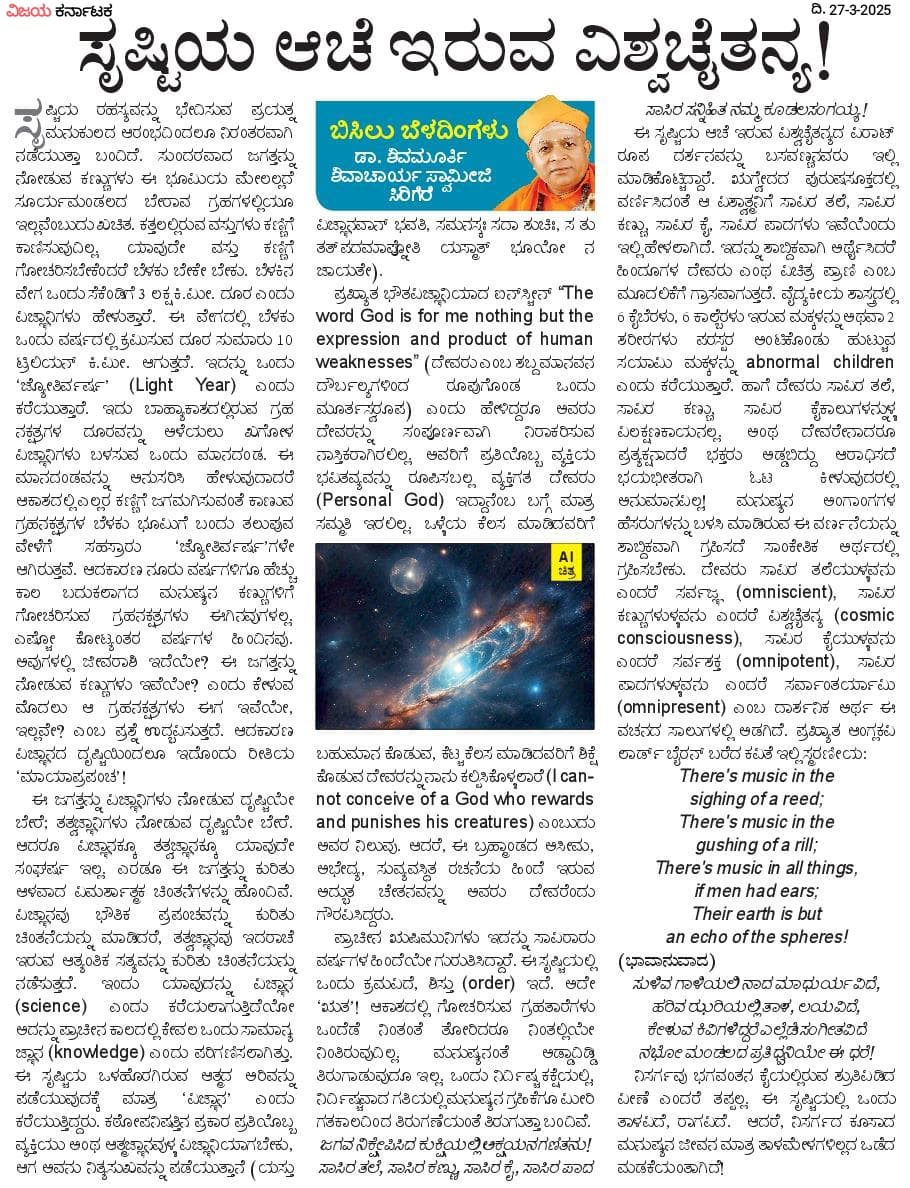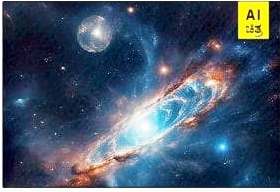аІёаіғаІ·аіҚаІҹаІҝаІҜ аІҶаІҡаіҶ аІҮаІ°аіҒаІө аІөаІҝаІ¶аіҚаІөаІҡаіҲаІӨаІЁаіҚаІҜ ! (The Cosmic Consciousness Beyond Creation!)
The Cosmic Consciousness Beyond Creation!


аІҲВ аІёаіғаІ·аіҚаІҹаІҝаІҜ аІ°аІ№аІёаіҚаІҜаІөаІЁаіҚаІЁаіҒ аІӯаіҮаІҰаІҝаІёаіҒаІө аІӘаіҚаІ°аІҜаІӨаіҚаІЁ аІ®аІЁаіҒаІ•аіҒаІІаІҰ аІҶаІ°аІӮаІӯаІҰаІҝаІӮаІҰаІІаіӮ аІЁаІҝаІ°аІӮаІӨаІ°аІөаІҫаІ—аІҝ аІЁаІЎаіҶаІҜаіҒаІӨаіҚаІӨаІҫ аІ¬аІӮаІҰаІҝаІҰаіҶ. аІҲ аІёаіҒаІӮаІҰаІ°аІөаІҫаІҰ аІңаІ—аІӨаіҚаІӨаІЁаіҚаІЁаіҒ аІЁаіӢаІЎаіҒаІө аІ•аІЈаіҚаІЈаіҒаІ—аІіаіҒ аІҲ аІӯаіӮаІ®аІҝаІҜ аІ®аіҮаІІаІІаіҚаІІаІҰаіҶ аІёаіӮаІ°аіҚаІҜаІ®аІӮаІЎаІІаІҰ аІ¬аіҮаІ°аІҫаІө аІ—аіҚаІ°аІ№аІ—аІіаІІаіҚаІІаІҝаІҜаіӮ аІҮаІІаіҚаІІаІөаіҶаІӮаІ¬аіҒаІҰаіҒ аІ–аІҡаІҝаІӨ. аІ•аІӨаіҚаІӨаІІаІІаіҚаІІаІҝаІ°аіҒаІө аІөаІёаіҚаІӨаіҒаІ—аІіаіҒ аІ•аІЈаіҚаІЈаІҝаІ—аіҶ аІ•аІҫаІЈаІҝаІёаіҒаІөаіҒаІҰаІҝаІІаіҚаІІ. аІҜаІҫаІөаіҒаІҰаіҮ аІөаІёаіҚаІӨаіҒ аІ•аІЈаіҚаІЈаІҝаІ—аіҶ аІ—аіӢаІҡаІ°аІҝаІёаІ¬аіҮаІ•аіҶаІӮаІҰаІ°аіҶ аІ¬аіҶаІіаІ•аіҒ аІ¬аіҮаІ•аіҮ аІ¬аіҮаІ•аіҒ. аІ¬аіҶаІіаІ•аІҝаІЁ аІөаіҮаІ— аІ’аІӮаІҰаіҒ аІёаіҶаІ•аіҶаІӮаІЎаІҝаІ—аіҶ 3 аІІаІ•аіҚаІ· аІ•аІҝ.аІ®аіҖ. аІҰаіӮаІ° аІҺаІӮаІҰаіҒ аІөаІҝаІңаіҚаІһаІҫаІЁаІҝаІ—аІіаіҒ аІ№аіҮаІіаіҒаІӨаіҚаІӨаІҫаІ°аіҶ. аІҲ аІөаіҮаІ—аІҰаІІаіҚаІІаІҝ аІ¬аіҶаІіаІ•аіҒ аІ’аІӮаІҰаіҒ аІөаІ°аіҚаІ·аІҰаІІаіҚаІІаІҝ аІ•аіҚаІ°аІ®аІҝаІёаіҒаІө аІҰаіӮаІ° аІёаіҒаІ®аІҫаІ°аіҒ аІ№аІӨаіҚаІӨаіҒ аІҹаіҚаІ°аІҝаІІаІҝаІҜаІЁаіҚ аІ•аІҝ.аІ®аіҖ аІҶаІ—аіҒаІӨаіҚаІӨаІҰаіҶ. аІҮаІҰаІЁаіҚаІЁаіҒ аІ’аІӮаІҰаіҒ аІңаіҚаІҜаіӢаІӨаІҝаІ°аіҚаІөаІ°аіҚаІ· (Light Year)В аІҺаІӮаІҰаіҒ аІ•аІ°аіҶаІҜаіҒаІӨаіҚаІӨаІҫаІ°аіҶ. аІҮаІҰаіҒ аІ¬аІҫаІ№аіҚаІҜаІҫаІ•аІҫаІ¶аІҰаІІаіҚаІІаІҝаІ°аіҒаІө аІ—аіҚаІ°аІ№аІЁаІ•аіҚаІ·аІӨаіҚаІ°аІ—аІі аІҰаіӮаІ°аІөаІЁаіҚаІЁаіҒ аІ…аІіаіҶаІҜаІІаіҒ аІ–аІ—аіӢаІі аІөаІҝаІңаіҚаІһаІҫаІЁаІҝаІ—аІіаіҒ аІ¬аІіаІёаіҒаІө аІ’аІӮаІҰаіҒ аІ®аІҫаІЁаІҰаІӮаІЎ. аІҲ аІ®аІҫаІЁаІҰаІӮаІЎаІөаІЁаіҚаІЁаіҒ аІ…аІЁаіҒаІёаІ°аІҝаІёаІҝ аІ№аіҮаІіаіҒаІөаіҒаІҰаІҫаІҰаІ°аіҶ аІҶаІ•аІҫаІ¶аІҰаІІаіҚаІІаІҝ аІҺаІІаіҚаІІаІ° аІ•аІЈаіҚаІЈаІҝаІ—аіҶ аІңаІ—аІ®аІ—аІҝаІёаіҒаІөаІӮаІӨаіҶ аІ•аІҫаІЈаіҒаІө аІ—аіҚаІ°аІ№аІЁаІ•аіҚаІ·аІӨаіҚаІ°аІ—аІі аІ¬аіҶаІіаІ•аіҒ аІӯаіӮаІ®аІҝаІ—аіҶ аІ¬аІӮаІҰаіҒ аІӨаІІаіҒаІӘаіҒаІө аІөаіҮаІіаіҶаІ—аіҶ аІёаІ№аІёаіҚаІ°аІҫаІ°аіҒ аІңаіҚаІҜаіӢаІӨаІҝаІ°аіҚаІөаІ°аіҚаІ·аІ—аІіаіҮ аІҶаІ—аІҝаІ°аіҒаІӨаіҚаІӨаІҰаіҶ. аІҶаІҰаІ•аІҫаІ°аІЈ аІЁаіӮаІ°аіҒ аІөаІ°аіҚаІ·аІ—аІіаІҝаІ—аіӮ аІ№аіҶаІҡаіҚаІҡаіҒ аІ•аІҫаІІ аІ¬аІҰаіҒаІ•аІІаІҫаІ—аІҰ аІ®аІЁаіҒаІ·аіҚаІҜаІЁ аІ•аІЈаіҚаІЈаіҒаІ—аІіаІҝаІ—аіҶ аІ—аіӢаІҡаІ°аІҝаІёаіҒаІө аІ—аіҚаІ°аІ№аІЁаІ•аіҚаІ·аІӨаіҚаІ°аІ—аІіаіҒ аІҲаІ—аІҝаІЁаІөаіҒаІ—аІіаІІаіҚаІІ. аІҺаІ·аіҚаІҹаіӢ аІ•аіӢаІҹаіҚаІҜаІӮаІӨаІ° аІөаІ°аіҚаІ·аІ—аІі аІ№аІҝаІӮаІҰаІҝаІЁаІөаіҒ. аІ…аІөаіҒаІ—аІіаІІаіҚаІІаІҝ аІңаіҖаІөаІ°аІҫаІ¶аІҝ аІҮаІҰаіҶаІҜаіҮ? аІҲ аІңаІ—аІӨаіҚаІӨаІЁаіҚаІЁаіҒ аІЁаіӢаІЎаіҒаІө аІ•аІЈаіҚаІЈаіҒаІ—аІіаіҒ аІҮаІөаіҶаІҜаіҮ? аІҺаІӮаІҰаіҒ аІ•аіҮаІіаіҒаІө аІ®аіҠаІҰаІІаіҒ аІҶ аІ—аіҚаІ°аІ№аІЁаІ•аіҚаІ·аІӨаіҚаІ°аІ—аІіаіҒ аІҲаІ— аІҮаІөаіҶаІҜаіҮ, аІҮаІІаіҚаІІаІөаіҮ? аІҺаІӮаІ¬ аІӘаіҚаІ°аІ¶аіҚаІЁаіҶ аІүаІҰаіҚаІӯаІөаІҝаІёаіҒаІӨаіҚаІӨаІҰаіҶ. аІҶаІҰаІ•аІҫаІ°аІЈ аІөаІҝаІңаіҚаІһаІҫаІЁаІҰ аІҰаіғаІ·аіҚаІҹаІҝаІҜаІҝаІӮаІҰаІІаіӮ аІҮаІҰаіҠаІӮаІҰаіҒ аІ°аіҖаІӨаІҝаІҜ аІ®аІҫаІҜаІҫаІӘаіҚаІ°аІӘаІӮаІҡ !
аІҲ аІңаІ—аІӨаіҚаІӨаІЁаіҚаІЁаіҒ аІөаІҝаІңаіҚаІһаІҫаІЁаІҝаІ—аІіаіҒ аІЁаіӢаІЎаіҒаІө аІҰаіғаІ·аіҚаІҹаІҝаІҜаіҮ аІ¬аіҮаІ°аіҶ; аІӨаІӨаіҚаІөаІңаіҚаІһаІҫаІЁаІҝаІ—аІіаіҒ аІЁаіӢаІЎаіҒаІө аІҰаіғаІ·аіҚаІҹаІҝаІҜаіҮ аІ¬аіҮаІ°аіҶ аІҶаІҰаІ°аіӮ аІөаІҝаІңаіҚаІһаІҫаІЁаІ•аіҚаІ•аіӮ аІӨаІӨаіҚаІөаІңаіҚаІһаІҫаІЁаІ•аіҚаІ•аіӮ аІҜаІҫаІөаіҒаІҰаіҮ аІёаІӮаІҳаІ°аіҚаІ· аІҮаІІаіҚаІІ. аІҺаІ°аІЎаіӮ аІёаІ№ аІҲ аІңаІ—аІӨаіҚаІӨаІЁаіҚаІЁаіҒ аІ•аіҒаІ°аІҝаІӨаіҒ аІҶаІіаІөаІҫаІҰ аІөаІҝаІ®аІ°аіҚаІ¶аІҫаІӨаіҚаІ®аІ• аІҡаІҝаІӮаІӨаІЁаіҶаІ—аІіаІЁаіҚаІЁаіҒ аІ№аіҠаІӮаІҰаІҝаІөаіҶ. аІөаІҝаІңаіҚаІһаІҫаІЁаІөаіҒ аІӯаіҢаІӨаІҝаІ• аІӘаіҚаІ°аІӘаІӮаІҡаІөаІЁаіҚаІЁаіҒ аІ•аіҒаІ°аІҝаІӨаіҒ аІҡаІҝаІӮаІӨаІЁаіҶаІҜаІЁаіҚаІЁаіҒ аІ®аІҫаІЎаІҝаІҰаІ°аіҶ, аІӨаІӨаіҚаІөаІңаіҚаІһаІҫаІЁаІөаіҒ аІҮаІҰаІ°аІҫаІҡаіҶ аІҮаІ°аіҒаІө аІҶаІӨаіҚаІҜаІӮаІӨаІҝаІ• аІёаІӨаіҚаІҜаІөаІЁаіҚаІЁаіҒ аІ•аіҒаІ°аІҝаІӨаіҒ аІҡаІҝаІӮаІӨаІЁаіҶаІҜаІЁаіҚаІЁаіҒ аІЁаІЎаіҶаІёаіҒаІӨаіҚаІӨаІҰаіҶ. аІҮаІӮаІҰаіҒ аІҜаІҫаІөаіҒаІҰаІЁаіҚаІЁаіҒ аІөаІҝаІңаіҚаІһаІҫаІЁ (science) аІҺаІӮаІҰаіҒ аІ•аІ°аіҶаІҜаІІаІҫаІ—аіҒаІӨаіҚаІӨаІҝаІҰаіҶаІҜаіӢ аІ…аІҰаІЁаіҚаІЁаіҒ аІӘаіҚаІ°аІҫаІҡаіҖаІЁ аІ•аІҫаІІаІҰаІІаіҚаІІаІҝ аІ•аіҮаІөаІІ аІ’аІӮаІҰаіҒ аІёаІҫаІ®аІҫаІЁаіҚаІҜ аІңаіҚаІһаІҫаІЁ (knowledge) аІҺаІӮаІҰаіҒ аІӘаІ°аІҝаІ—аІЈаІҝаІёаІІаІҫаІ—аІҝаІӨаіҚаІӨаіҒ. аІҲ аІёаіғаІ·аіҚаІҹаІҝаІҜ аІ’аІіаІ№аіҠаІ°аІ—аІҝаІ°аіҒаІө аІҶаІӨаіҚаІ®аІҰ аІ…аІ°аІҝаІөаІЁаіҚаІЁаіҒ аІӘаІЎаіҶаІҜаіҒаІөаіҒаІҰаІ•аіҚаІ•аіҶ аІ®аІҫаІӨаіҚаІ° вҖңаІөаІҝаІңаіҚаІһаІҫаІЁвҖқ аІҺаІӮаІҰаіҒ аІ•аІ°аіҶаІҜаіҒаІӨаіҚаІӨаІҝаІҰаіҚаІҰаІ°аіҒ. аІ•аІ аіӢаІӘаІЁаІҝаІ·аІӨаіҚаІӨаІҝаІЁ аІӘаіҚаІ°аІ•аІҫаІ° аІӘаіҚаІ°аІӨаІҝаІҜаіҠаІ¬аіҚаІ¬ аІөаіҚаІҜаІ•аіҚаІӨаІҝаІҜаіҒ аІ…аІӮаІӨаІ№ аІҶаІӨаіҚаІ®аІңаіҚаІһаІҫаІЁаІөаіҒаІіаіҚаІі аІөаІҝаІңаіҚаІһаІҫаІЁаІҝаІҜаІҫаІ—аІ¬аіҮаІ•аіҒ. аІҶаІ— аІ…аІөаІЁаіҒ аІЁаІҝаІӨаіҚаІҜаІёаіҒаІ–аІөаІЁаіҚаІЁаіҒ аІӘаІЎаіҶаІҜаіҒаІӨаіҚаІӨаІҫаІЁаіҶ (аІҜаІёаіҚаІӨаіҒ аІөаІҝаІңаіҚаІһаІҫаІЁаІөаІҫаІЁаіҚ аІӯаІөаІӨаІҝ, аІёаІ®аІЁаІёаіҚаІ•аІғ аІёаІҰаІҫ аІ¶аіҒаІҡаІҝаІғ, аІё аІӨаіҒ аІӨаІӨаіҚвҖҢаІӘаІҰаІ®аІҫаІӘаіҚаІӘаіӢаІӨаІҝ аІҜаІёаіҚаІ®аІҫаІӨаіҚ аІӯаіӮаІҜаіӢ аІЁ аІңаІҫаІҜаІӨаіҮ).
аІӘаіҚаІ°аІ–аіҚаІҜаІҫаІӨ аІӯаіҢаІӨаІөаІҝаІңаіҚаІһаІҫаІЁаІҝаІҜаІҫаІҰ аІҗаІЁаіҚвҖҢаІёаіҚаІҹаіҲаІЁаіҚ вҖңThe word God is for me nothing but the expression and product of human weaknesses" (аІҰаіҮаІөаІ°аіҒ аІҺаІӮаІ¬ аІ¶аІ¬аіҚаІҰ аІ®аІҫаІЁаІөаІЁ аІҰаіҢаІ°аіҚаІ¬аІІаіҚаІҜаІ—аІіаІҝаІӮаІҰ аІ°аіӮаІӘаіҒаІ—аіҠаІӮаІЎ аІ’аІӮаІҰаіҒ аІ®аіӮаІ°аіҚаІӨаІёаіҚаІөаІ°аіӮаІӘ) аІҺаІӮаІҰаіҒ аІ№аіҮаІіаІҝаІҰаіҚаІҰаІ°аіӮ аІ…аІөаІ°аіҒ аІҰаіҮаІөаІ°аІЁаіҚаІЁаіҒ аІёаІӮаІӘаіӮаІ°аіҚаІЈаІөаІҫаІ—аІҝ аІЁаІҝаІ°аІҫаІ•аІ°аІҝаІёаіҒаІө аІЁаІҫаІёаіҚаІӨаІҝаІ•аІ°аІҫаІ—аІҝаІ°аІІаІҝаІІаіҚаІІ. аІ…аІөаІ°аІҝаІ—аіҶ аІӘаіҚаІ°аІӨаІҝаІҜаіҠаІ¬аіҚаІ¬ аІөаіҚаІҜаІ•аіҚаІӨаІҝаІҜ аІӯаІөаІҝаІӨаІөаіҚаІҜаІөаІЁаіҚаІЁаіҒ аІ°аіӮаІӘаІҝаІёаІ¬аІІаіҚаІІ аІөаіҚаІҜаІ•аіҚаІӨаІҝаІ—аІӨ аІҰаіҮаІөаІ°аіҒ (Personal God) аІҮаІҰаіҚаІҰаІҫаІЁаіҶаІӮаІ¬ аІ¬аІ—аіҚаІ—аіҶ аІ®аІҫаІӨаіҚаІ° аІёаІ®аіҚаІ®аІӨаІҝ аІҮаІ°аІІаІҝаІІаіҚаІІ. аІ’аІіаіҚаІіаіҶаІҜ аІ•аіҶаІІаІё аІ®аІҫаІЎаІҝаІҰаІөаІ°аІҝаІ—аіҶ аІ¬аІ№аіҒаІ®аІҫаІЁ аІ•аіҠаІЎаіҒаІө, аІ•аіҶаІҹаіҚаІҹ аІ•аіҶаІІаІё аІ®аІҫаІЎаІҝаІҰаІөаІ°аІҝаІ—аіҶ аІ¶аІҝаІ•аіҚаІ·аіҶ аІ•аіҠаІЎаіҒаІө аІҰаіҮаІөаІ°аІЁаіҚаІЁаіҒ аІЁаІҫаІЁаіҒ аІ•аІІаіҚаІӘаІҝаІёаІҝаІ•аіҠаІіаіҚаІіаІІаІҫаІ°аіҶ (I cannot conceive of a God who rewards and punishes his creatures) аІҺаІӮаІ¬аіҒаІҰаіҒ аІ…аІөаІ° аІЁаІҝаІІаіҒаІөаІҫаІ—аІҝаІӨаіҚаІӨаіҒ. аІҶаІҰаІ°аіҶ аІҲ аІ¬аіҚаІ°аІ№аіҚаІ®аІҫаІӮаІЎаІҰ аІ…аІёаіҖаІ®, аІ…аІӯаіҮаІҰаіҚаІҜ, аІёаіҒаІөаіҚаІҜаІөаІёаіҚаІҘаІҝаІӨ аІ°аІҡаІЁаіҶаІҜ аІ№аІҝаІӮаІҰаіҶ аІҮаІ°аіҒаІө аІ…аІҰаіҚаІӯаіҒаІӨ аІҡаіҮаІӨаІЁаІөаІЁаіҚаІЁаіҒ аІ…аІөаІ°аіҒ аІҰаіҮаІөаІ°аіҶаІӮаІҰаіҒ аІ—аіҢаІ°аІөаІҝаІёаІҝаІҰаіҚаІҰаІ°аіҒ.

аІӘаіҚаІ°аІҫаІҡаіҖаІЁ аІӢаІ·аІҝаІ®аіҒаІЁаІҝаІ—аІіаіҒ аІҮаІҰаІЁаіҚаІЁаіҒ аІёаІҫаІөаІҝаІ°аІҫаІ°аіҒ аІөаІ°аіҚаІ·аІ—аІі аІ№аІҝаІӮаІҰаіҶаІҜаіҮ аІ—аіҒаІ°аіҒаІӨаІҝаІёаІҝаІҰаіҚаІҰаІҫаІ°аіҶ. аІҲ аІёаіғаІ·аіҚаІҹаІҝаІҜаІІаіҚаІІаІҝ аІ’аІӮаІҰаіҒ аІ•аіҚаІ°аІ®аІөаІҝаІҰаіҶ, аІ¶аІҝаІёаіҚаІӨаіҒ (order) аІҮаІҰаіҶ. аІ…аІҰаіҮ вҖңаІӢаІӨ!вҖқ аІҶаІ•аІҫаІ¶аІҰаІІаіҚаІІаІҝ аІ—аіӢаІҡаІ°аІҝаІёаіҒаІө аІ—аіҚаІ°аІ№аІӨаІҫаІ°аіҶаІ—аІіаіҒ аІ’аІӮаІҰаіҶаІЎаіҶ аІЁаІҝаІӮаІӨаІӮаІӨаіҶ аІӨаіӢаІ°аІҝаІҰаІ°аіӮ аІЁаІҝаІӮаІӨаІІаіҚаІІаІҝаІҜаіҮ аІЁаІҝаІӮаІӨаІҝаІ°аіҒаІөаіҒаІҰаІҝаІІаіҚаІІ. аІ®аІЁаіҒаІ·аіҚаІҜаІЁаІӮаІӨаіҶ аІ…аІЎаіҚаІЎаІҫаІҰаІҝаІЎаіҚаІЎаІҝ аІӨаІҝаІ°аіҒаІ—аІҫаІЎаіҒаІөаіҒаІҰаіӮ аІҮаІІаіҚаІІ. аІ’аІӮаІҰаіҒ аІЁаІҝаІ°аіҚаІҰаІҝаІ·аіҚаІҹ аІ•аІ•аіҚаІ·аіҶаІҜаІІаіҚаІІаІҝ аІЁаІҝаІ°аіҚаІҰаІҝаІ·аіҚаІҹаІөаІҫаІҰ аІ—аІӨаІҝаІҜаІІаіҚаІІаІҝ аІ®аІЁаіҒаІ·аіҚаІҜаІЁ аІ—аіҚаІ°аІ№аІҝаІ•аіҶаІ—аіӮ аІ®аіҖаІ°аІҝ аІ—аІӨаІ•аІҫаІІаІҰаІҝаІӮаІҰ аІӨаІҝаІ°аіҒаІ—аІЈаіҶаІҜаІӮаІӨаіҶ аІӨаІҝаІ°аіҒаІ—аіҒаІӨаіҚаІӨаІҫ аІ¬аІӮаІҰаІҝаІөаіҶ.
аІңаІ—аІө аІЁаІҝаІ•аіҚаІ·аіҮаІӘаІҝаІёаІҝаІҰ аІ•аіҒаІ•аіҚаІ·аІҝаІҜаІІаіҚаІІаІҝ аІ…аІ•аіҚаІ·аІҜаІЁаІ—аІЈаІҝаІӨаІЁаіҒ!
аІёаІҫаІёаІҝаІ° аІӨаІІаіҶ, аІёаІҫаІёаІҝаІ° аІ•аІЈаіҚаІЈаіҒ, аІёаІҫаІёаІҝаІ° аІ•аіҲ, аІёаІҫаІёаІҝаІ° аІӘаІҫаІҰ
аІёаІҫаІёаІҝаІ° аІёаІЁаіҚаІЁаІҝаІ№аІҝаІӨ аІЁаІ®аіҚаІ® аІ•аіӮаІЎаІІаІёаІӮаІ—аІҜаіҚаІҜ!
аІҲ аІёаіғаІ·аіҚаІҹаІҝаІҜ аІҶаІҡаіҶ аІҮаІ°аіҒаІө аІөаІҝаІ¶аіҚаІөаІҡаіҲаІӨаІЁаіҚаІҜаІҰ аІөаІҝаІ°аІҫаІЎаіҚвҖҢаІ°аіӮаІӘ аІҰаІ°аіҚаІ¶аІЁаІөаІЁаіҚаІЁаіҒ аІ¬аІёаІөаІЈаіҚаІЈаІЁаІөаІ°аіҒ аІҮаІІаіҚаІІаІҝ аІ®аІҫаІЎаІҝаІ•аіҠаІҹаіҚаІҹаІҝаІҰаіҚаІҰаІҫаІ°аіҶ. "аІёаІ№аІёаіҚаІ°аІ¶аіҖаІ°аіҚаІ·аІҫ аІӘаіҒаІ°аіҒаІ·аІғ аІёаІ№аІёаіҚаІ°аІҫаІ•аіҚаІ·аІҫаІӨаіҚ аІёаІ№аІёаіҚаІ°аІӘаІҫаІӨаіҚ" аІҺаІӮаІҰаіҒ аІӢаІ—аіҚаІөаіҮаІҰаІҰ аІӘаіҒаІ°аіҒаІ·аІёаіӮаІ•аіҚаІӨаІҰаІІаіҚаІІаІҝ аІөаІ°аіҚаІЈаІҝаІёаІҝаІҰаІӮаІӨаіҶ аІҶ аІөаІҝаІ¶аіҚаІөаІҫаІӨаіҚаІ®аІЁаІҝаІ—аіҶ аІёаІҫаІөаІҝаІ° аІӨаІІаіҶ, аІёаІҫаІөаІҝаІ° аІ•аІЈаіҚаІЈаіҒ, аІёаІҫаІөаІҝаІ° аІ•аіҲ, аІёаІҫаІөаІҝаІ° аІӘаІҫаІҰаІ—аІіаіҒ аІҮаІөаіҶаІҜаіҶаІӮаІҰаіҒ аІҮаІІаіҚаІІаІҝ аІ№аіҮаІіаІІаІҫаІ—аІҝаІҰаіҶ. аІҮаІҰаІЁаіҚаІЁаіҒ аІ¶аІҫаІ¬аіҚаІҰаІҝаІ•аІөаІҫаІ—аІҝ аІ…аІ°аіҚаІҘаіҲаІёаІҝаІҰаІ°аіҶ аІ№аІҝаІӮаІҰаіӮаІ—аІі аІҰаіҮаІөаІ°аіҒ аІҺаІӮаІӨаІ№ аІөаІҝаІҡаІҝаІӨаіҚаІ° аІӘаіҚаІ°аІҫаІЈаІҝ аІҺаІӮаІ¬ аІ®аіӮаІҰаІІаІҝаІ•аіҶаІ—аіҶ аІ—аіҚаІ°аІҫаІёаІөаІҫаІ—аіҒаІӨаіҚаІӨаІҰаіҶ. аІөаіҲаІҰаіҚаІҜаІ•аіҖаІҜ аІ¶аІҫаІёаіҚаІӨаіҚаІ°аІҰаІІаіҚаІІаІҝ аІҶаІ°аіҒ аІ•аіҲаІ¬аіҶаІ°аІіаіҒ, аІҶаІ°аіҒ аІ•аІҫаІІаіҚаІ¬аіҶаІ°аІіаіҒ аІҮаІ°аіҒаІө аІ®аІ•аіҚаІ•аІіаІЁаіҚаІЁаіҒ аІ…аІҘаІөаІҫ аІҺаІ°аІЎаіҒ аІ¶аІ°аіҖаІ°аІ—аІіаіҒ аІӘаІ°аІёаіҚаІӘаІ° аІ…аІӮаІҹаІҝаІ•аіҠаІӮаІЎаіҒ аІ№аіҒаІҹаіҚаІҹаіҒаІө аІёаІҜаІҫаІ®аІҝ аІ®аІ•аіҚаІ•аІіаІЁаіҚаІЁаіҒ abnormal children аІҺаІӮаІҰаіҒ аІ•аІ°аіҶаІҜаіҒаІӨаіҚаІӨаІҫаІ°аіҶ. аІ№аІҫаІ—аіҶ аІҰаіҮаІөаІ°аіҒ аІёаІҫаІөаІҝаІ° аІӨаІІаіҶ, аІёаІҫаІөаІҝаІ° аІ•аІЈаіҚаІЈаіҒ, аІёаІҫаІөаІҝаІ° аІ•аіҲаІ•аІҫаІІаіҒаІ—аІіаІЁаіҚаІЁаіҒаІіаіҚаІі аІөаІҝаІІаІ•аіҚаІ·аІЈаІ•аІҫаІҜаІЁаІІаіҚаІІ. аІ…аІӮаІӨаІ№ аІҰаіҮаІөаІ°аіҮаІЁаІҫаІҰаІ°аіӮ аІӘаіҚаІ°аІӨаіҚаІҜаІ•аіҚаІ·аІЁаІҫаІҰаІ°аіҶ аІӯаІ•аіҚаІӨаІ°аіҒ аІ…аІЎаіҚаІЎаІ¬аІҝаІҰаіҚаІҰаіҒ аІҶаІ°аІҫаІ§аІҝаІёаІҰаіҶ аІӯаІҜаІӯаіҖаІӨаІ°аІҫаІ—аІҝ аІ“аІҹ аІ•аіҖаІіаіҒаІөаіҒаІҰаІ°аІІаіҚаІІаІҝ аІ…аІЁаіҒаІ®аІҫаІЁаІөаІҝаІІаіҚаІІ! аІ®аІЁаіҒаІ·аіҚаІҜаІЁ аІ…аІӮаІ—аІҫаІӮаІ—аІ—аІі аІ№аіҶаІёаІ°аіҒаІ—аІіаІЁаіҚаІЁаіҒ аІ¬аІіаІёаІҝ аІ®аІҫаІЎаІҝаІ°аіҒаІө аІҲ аІөаІ°аіҚаІЈаІЁаіҶаІҜаІЁаіҚаІЁаіҒ аІ¶аІҫаІ¬аіҚаІҰаІҝаІ•аІөаІҫаІ—аІҝ аІ—аіҚаІ°аІ№аІҝаІёаІҰаіҶ аІёаІҫаІӮаІ•аіҮаІӨаІҝаІ• аІ…аІ°аіҚаІҘаІҰаІІаіҚаІІаІҝ аІ—аіҚаІ°аІ№аІҝаІёаІ¬аіҮаІ•аіҒ. аІҰаіҮаІөаІ°аіҒ аІёаІҫаІөаІҝаІ° аІӨаІІаіҶаІҜаіҒаІіаіҚаІіаІөаІЁаіҒ аІҺаІӮаІҰаІ°аіҶ аІёаІ°аіҚаІөаІңаіҚаІһ (omniscient), аІёаІҫаІөаІҝаІ° аІ•аІЈаіҚаІЈаіҒаІ—аІіаіҒаІіаіҚаІіаІөаІЁаіҒ аІҺаІӮаІҰаІ°аіҶ аІөаІҝаІ¶аіҚаІөаІҡаіҲаІӨаІЁаіҚаІҜ (cosmic consciousness), аІёаІҫаІөаІҝаІ° аІ•аіҲаІҜаіҒаІіаіҚаІіаІөаІЁаіҒ аІҺаІӮаІҰаІ°аіҶ аІёаІ°аіҚаІөаІ¶аІ•аіҚаІӨ (omnipotent), аІёаІҫаІөаІҝаІ° аІӘаІҫаІҰаІ—аІіаіҒаІіаіҚаІіаІөаІЁаіҒ аІҺаІӮаІҰаІ°аіҶ аІёаІ°аіҚаІөаІҫаІӮаІӨаІ°аіҚаІҜаІҫаІ®аІҝ (omnipresent) аІҺаІӮаІ¬ аІҰаІҫаІ°аіҚаІ¶аІЁаІҝаІ• аІ…аІ°аіҚаІҘ аІҲ аІөаІҡаІЁаІҰ аІёаІҫаІІаіҒаІ—аІіаІІаіҚаІІаІҝ аІ…аІЎаІ—аІҝаІҰаіҶ. аІӘаіҚаІ°аІ–аіҚаІҜаІҫаІӨ аІҶаІӮаІ—аіҚаІІаІ•аІөаІҝ аІІаІҫаІ°аіҚаІЎаіҚ аІ¬аіҲаІ°аІЁаіҚ аІ¬аІ°аіҶаІҰ аІ•аІөаІҝаІӨаіҶ аІҮаІІаіҚаІІаІҝ аІёаіҚаІ®аІ°аІЈаіҖаІҜ:
There's music in the sighing of a ree;
There's music in the gushing of a rill;В
There's music in all things, if men had ears;
Their earth is but an echo of the spheres!
(аІӯаІҫаІөаІҫаІЁаіҒаІөаІҫаІҰ)
аІёаіҒаІіаІҝаІө аІ—аІҫаІіаІҝаІҜаІІаІҝ аІЁаІҫаІҰ аІ®аІҫаІ§аіҒаІ°аіҚаІҜаІөаІҝаІҰаіҶ,
аІ№аІ°аІҝаІө аІқаІ°аІҝаІҜаІІаіҚаІІаІҝ аІӨаІҫаІі, аІӨаІҫаІЁаІөаІҝаІҰаіҶ,В
аІ•аіҮаІіаіҒаІө аІ•аІҝаІөаІҝаІ—аІіаІҝаІҰаіҚаІҰаІ°аіҶ аІҺаІІаіҚаІІаіҶаІЎаіҶ аІёаІӮаІ—аіҖаІӨаІөаІҝаІҰаіҶВ
аІ§аІ°аіҶаІҜ аІЁаІҝаІЁаІҫаІҰ аІЁаІӯаіӢ аІ®аІӮаІЎаІІаІҰаІҝ аІ®аІҫаІ°аіҚаІҰаІЁаІҝаІ—аіҠаІіаіҚаІіаіҒаІӨаІІаІҝаІҰаіҶ!
аІЁаІҝаІёаІ°аіҚаІ—аІөаіҒ аІӯаІ—аІөаІӮаІӨаІЁ аІ•аіҲаІҜаІІаіҚаІІаІҝаІ°аіҒаІө аІ¶аіҚаІ°аіҒаІӨаІҝаІ—аіҲаІҰ аІөаіҖаІЈаіҶ . аІҲ аІёаіғаІ·аіҚаІҹаІҝаІҜаІІаіҚаІІаІҝ аІ’аІӮаІҰаіҒ аІӨаІҫаІіаІөаІҝаІҰаіҶ, аІ°аІҫаІ—аІөаІҝаІҰаіҶ. аІҶаІҰаІ°аіҶ аІЁаІҝаІёаІ°аіҚаІ—аІҰ аІ•аіӮаІёаІҫаІҰ аІ®аІЁаіҒаІ·аіҚаІҜаІЁ аІңаіҖаІөаІЁ аІ®аІҫаІӨаіҚаІ° аІ°аІҫаІ— аІӨаІҫаІіаІ®аіҮаІіаІ—аІіаІҝаІІаіҚаІІаІҰ аІ’аІЎаіҶаІҰ аІ®аІЎаІ•аіҶаІҜаІӮаІӨаІҫаІ—аІҝаІҰаіҶ...!
-аІ¶аіҚаІ°аіҖ аІӨаІ°аІіаІ¬аІҫаІіаіҒ аІңаІ—аІҰаіҚаІ—аіҒаІ°аіҒ
аІЎаІҫ|| аІ¶аІҝаІөаІ®аіӮаІ°аіҚаІӨаІҝ аІ¶аІҝаІөаІҫаІҡаІҫаІ°аіҚаІҜ аІ®аІ№аІҫаІёаіҚаІөаІҫаІ®аІҝаІ—аІіаІөаІ°аіҒ
аІёаІҝаІ°аІҝаІ—аіҶаІ°аіҶ.
аІөаІҝаІңаІҜ аІ•аІ°аіҚаІЁаІҫаІҹаІ•В
аІ¬аІҝаІёаІҝаІІаіҒ аІ¬аіҶаІіаІҰаІҝаІӮаІ—аІіаіҒ (27.3.2025)



